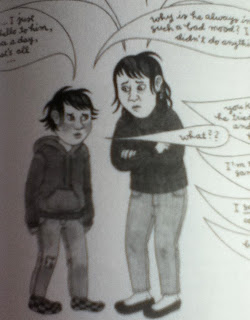 |
| A white crowned sparrow. |
Over and over, I found resonance with my personal life, with my love of birds, with books I've read and art I've seen. I'll use footnotes to link to a few of them. When Women Were Birds is a treasure that flew straight to my heart. I flagged so many passages that it'll be a challenge to select only some of them here.
The physical design of this small book is lovely and reflects the word repetition Williams employs in the text, except in avian form. The white dust jacket is embossed with a pattern of white birds in flight. The flyleaf features a pattern of overlapping feathers. Repeating black silhouettes of a bird in various stages of flight are positioned on the inside pages in such a way that the bird can be animated by flipping through the pages quickly.
Terry Tempest Williams writes that the title When Women Were Birds came to her in a dream. I think of tales from Greek mythology in which women turn into birds, and also the bird goddess figurines of Old Europe. (1)
 |
| Bird goddess figurines at the Louvre. |
Raised in the Mormon faith, Williams writes "Indoor religion bored me; outdoor religion did not." She found her senses "more trustworthy than any religious doctrine."
Conceptual art (3) like John Cage's silent concerto, known as 4' 33", and Robert Rauschenberg's White Paintings give Williams insight into her mother's blank journals:
"My Mother's Journals are theatrical. [...] My Mother's Journals are a transgression. My Mother's Journals are a scandal of white. My Mother's Journals are a "harmony of silence."
When her grandmother gave her the book Creation Myths by Marie-Louise von Franz, Williams didn't initially understand it as a subversive text. "What I came to appreciate was how the transgression of Eve was an act that led us out of the garden and into the wilderness. Who wants to be a goddess when we can be human? Perfection is a flaw disguised as control. The moment Eve bit into the apple, her eyes opened and she became free. She exposed the truth of what every woman knows: to find our sovereign voice often requires a betrayal. We just have to make certain we do not betray ourselves. For a woman or a man to speak from the truth of their heart is to break taboo. The mask is removed. The snake who tempted Eve to eat the forbidden fruit was not the Devil, but her own instinctive nature saying, Honour your hunger and feed yourself."
"On October 16, 1916, Margaret Sanger opened the first family planning and birth control center on 46 Amboy Street in the Brownsville neighbourhood of Brooklyn." Williams' mother had her tubes tied -- "not a common practice among her peers," -- and later said it was for "freedom." (4)
"I am a woman with wings dancing with other women with wings. In a voiced community, we all flourish." (5)
Listening to an opera by Strauss left Williams enraptured: "Would you believe me if I told you when I opened my mouth a bird flew out?" (6)
"Cancer. So much cancer. Nine women in my family have all had mastectomies, and seven are dead." Williams' grief paralyzed her. Her husband suggested that walking would help. "Every day, I walked. It was not a meditation, but survival, one foot in front of the other, with my eyes focused down, trying to stay steady." (7)
"To look at the script of Nushu is to see bird tracks, crows walking deliberately down a narrow path of snow. [...] This is the secret script of women, used for hundreds of years in the rural villages of Jiangyong in Hunan Province of China." (8)
"How shall I live? [...] We cannot do it alone. We do it alone."
"Once upon a time, when women were birds, there was the simple understanding that to sing at dawn and to sing at dusk was to heal the world through joy. The birds still remember what we have forgotten, that the world is meant to be celebrated."
 |
| One of my early pastel paintings, inspired by a photo on the dust jacket of a book about the mythology surrounding different animals and birds. |
(1) If We Were Birds (Erin Shields)
(2) You Are Stardust (Elin Kelsey)
(3) Glittering Images (Camille Paglia)
(4) Unterzakhn (Leela Corman) and details from the edge of the village (Pierrette Requier)
(5) The soundtrack in my head while I read this book was the chant "A River of Birds" as performed by Libana. ("There's a river of birds in migration, a nation of women with wings.")
(6) Raven Girl (Audrey Niffenegger)
(7) Wild (Cheryl Strayed)
(8) Snow Flower and the Secret Fan (Lisa See)



























